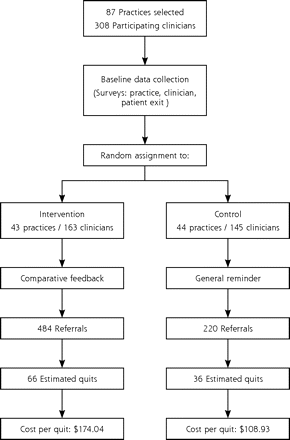Practice-based referrals to a tobacco cessation quit line: assessing the impact of comparative feedback vs general reminders
- PMID: 17389537
- PMCID: PMC1838696
- DOI: 10.1370/afm.650
Practice-based referrals to a tobacco cessation quit line: assessing the impact of comparative feedback vs general reminders
Abstract
Purpose: We undertook a study to assess the impact of comparative feedback vs general reminders on practice-based referrals to a tobacco cessation quit line and estimated costs for projected quit responses.
Methods: We conducted a group-randomized clinical trial comparing the impact of 6 quarterly (18 months) feedback reports (intervention) with that of general reminders (control) on practice-based clinician referrals to a quit-line service. Feedback reports were based on an Achievable Benchmark of Care approach using baseline practice, clinician, and patient survey responses, and referrals per quarter. Comparable quit responses and costs were estimated.
Results: Three hundred eight clinicians participated (171 family medicine, 88 internal medicine, 49 obstetrics-gynecology) from 87 primary care practices in Michigan. After 18 months, there were more referrals from the intervention than from the control practices (484 vs 220; P <.001). Practice facsimile (fax) referrals (84%, n = 595) exceeded telephone referrals (16%, n = 109), but telephone referrals resulted in greater likelihood of enrollment (77% telephone vs 44% fax, P <.001). The estimated number of smokers who quit based on the level of services utilized by referred smokers was 66 in the feedback and 36 in the gentle reminder practices.
Conclusion: Providing comparative feedback on clinician referrals to a quit-line service had a modest impact with limited increased costs.
Figures
References
-
- Fiore M, Bailey W, Cohen S. Treating Tobacco Use and Dependence. Clinical Practice Guideline. Rockville, MD: US Department of Health and Human Services, Public Health Service; 2000.
-
- Cummings SR, Stein MJ, Hansen B, et al. Smoking counseling and preventive medicine. A survey of internists in private practices and a health maintenance organization. Arch Intern Med. 1989;149(2):345–349. - PubMed
-
- Thorndike AN, Rigotti NA, Stafford RS, Singer DE. National patterns in the treatment of smokers by physicians. JAMA. 1998;279(8):604–608. - PubMed
-
- Glynn T, Manley M. How to help your patients stop smoking. A National Cancer Institute Manuel for Physicians. US Dept of Health; 1989. NIH 89–3064.
Publication types
MeSH terms
LinkOut - more resources
Full Text Sources
Medical



